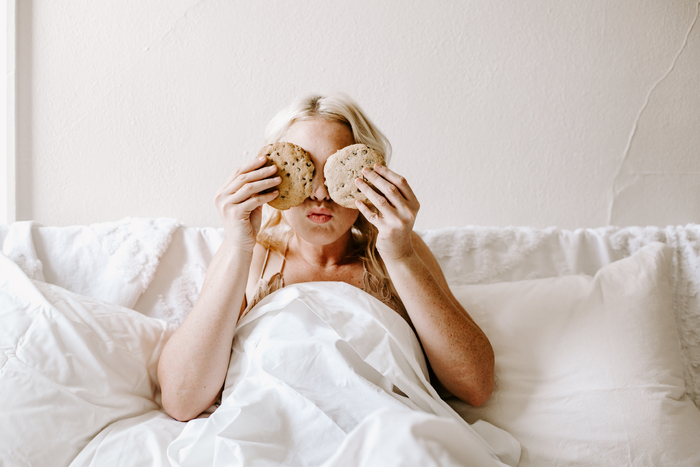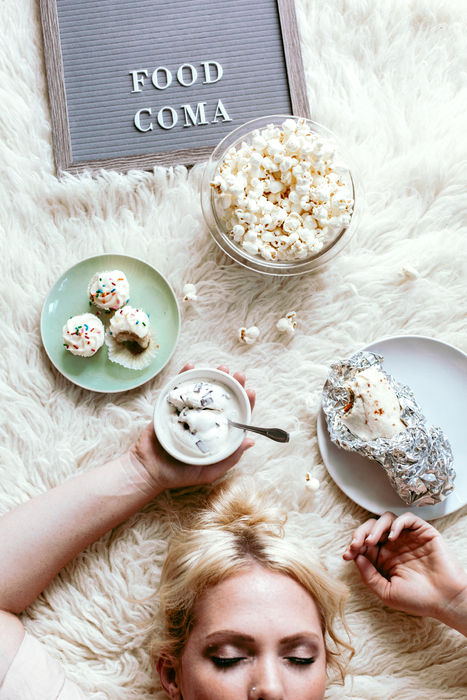Food cravings we all get them
They’re the intense urge to find and eat chocolate (or crisps, biscuits, ice cream) even though we aren’t hungry. When we get a craving, no other food will suffice.
Food cravings can rise up when we least expect it. And, they often make themselves known at the wrong times, like when we really need a glass of water, an apple, sleep, or even a little less stress.
This article is all about food cravings: what causes them and how to curb them.
Table of Contents
Before we dive in, I want to be clear that food cravings are not your fault. They are very common and are not a sign of bad choices. Most of all, having or giving in to food cravings does not reflect your value as a person. Food cravings are a normal part of human physiology, hard-wired in neuroscience and hormones (and a few other biological aspects)
Plus, food cravings are not insurmountable. There are some smart and not-so-obvious things you can do to reduce their impact on you if you want to.
In this article, I’m sharing a few strategies you can use that don’t require willpower of steel. We’ve all felt what it’s like to be hungry, have an appetite, and experience an intense food craving. Hunger is the feeling we get when our stomachs are empty. Appetite is the desire to eat food.
Cravings are different

Harvard Health defines cravings as, “an intense urge to eat a certain food-ideally right away.” While hunger can be alleviated by eating any food, cravings are very specific for a single type of food, like chocolate (the most commonly craved food and one of my favourites).
Plus, cravings can pop up at any moment-we can crave a certain food even if we have just finished filling up on dinner and we’re not hungry at all.
What causes food cravings?
Food cravings can be specific and are usually directed toward sweet, salty, or fatty foods. And they’re not only the result of having a “sweet tooth,” easy access to craveable foods, or lack of control of our behaviour.
There are also several complex-and common-physiological causes of cravings. Many of these are hard-wired into our brains and are naturally regulated by hormones and other biochemicals
Top four causes of food cravings
We’ll start with the top four causes, according to the Cleveland Clinic: food euphoria, feeling stressed, lack of sleep, and day-to-day habits.
Food euphoria
Is when the food we eat taps into the “feel good” centres that are hard-wired in the neurons of the brain. In addition to the “feel good” neurotransmitter called dopamine, crave-able foods also stimulate the release of hormones that impact metabolism, stress levels, and appetite This euphoria feels like a pleasurable reward and can naturally make us want to continue to eat that particular food, generating even more cravings for it
Feeling stressed
Can make our food cravings even more powerful, especially when that stress is over the long term. Increased levels of stress hormones like cortisol start up our “fight or flight” instincts that get us to look for food so we can get the energy we need to fight or flee. Eating the craved food provides us with some relief from that stress and helps us to cope with, or even distract from, stressful feelings-even if the coping and distraction are temporary
Lack of sleep
Can strengthen cravings due to its impact on our hormones. For example, not getting enough sleep places additional stress on our bodies and that further increases our desires for certain foods. Lack of sleep can also induce hunger by increasing the hunger hormone ghrelin and decreasing the fullness hormone leptin.
Day-to-day habits
May also play a part in cravings. Sometimes, if we’re used to enjoying snacks when we feel a certain way (e.g., stressed or tired) or are doing certain activities (e.g., driving, scrolling social media, or watching TV), then this habit can perpetuate our cravings and have us almost automatically reaching for craved foods before we can think about it.
In addition to these four causes of food cravings, other factors can contribute. For example, seeing or smelling a crave-able food can spark cravings, as can hormonal fluctuations that occur during the menstrual cycle. Some medications are known to increase appetite. And new research is looking into possible connections between food cravings and our genes and gut microbiota.

How to curb those cravings
We don’t want to prevent ourselves from eating if we’re truly hungry. However, there may be times when we’re craving something that we know we don’t have room for and is not going to serve our health. In these cases, there are a few tips you can try to help curb those cravings.
Try drinking water
It’s possible that sometimes what feels like hunger (or even a craving) is simply thirst. By staying hydrated throughout the day we can reduce the number of times we think we need to eat something.
Be more mindful
If we can stop for a second to catch ourselves craving foods or eating when we’re not hungry, mindfulness may help. Consider asking yourself if your food craving could be due to stress, boredom, anger, fatigue, or if you are in fact hungry. Maybe try breathing deeply for a few minutes, putting on a short meditation podcast, or going for a quick walk to reconnect with your inner self before taking another bite.
As you eat, continue your mindfulness practice by enjoying your food mindfully and without judgment. Harvard Health defines mindful eating as, “using all of your physical and emotional senses to experience and enjoy the food choices you make.” By mindfully paying attention to the thoughts and emotions that may fuel a craving, we can slow down and truly appreciate food. We can take smaller amounts, smell and appreciate the flavours, chew the food thoroughly, and relax between bites.
Balance meals
By eating meals that are highly nutritious and contain protein and fibre, you can feel fuller quicker and stay full longer. Also consider eating regularly throughout the day, as longer stretches between meals can intensify feelings of hunger and lead to eating too much, too fast, or eating foods that are too convenient, e.g., crave-able (and not as nutritious)
Make nutritious snacks more convenient
Many of us end up craving and snacking on convenience foods because . . . they’re convenient. It’s quick and easy to open a bar of chocolate and start enjoying it. But we can make more nutritious foods just as convenient by washing, chopping, and packaging fruits and vegetables, and having some grab-and-go dips and spreads available like nut butter, hummus, plain yoghurt, salsa, or guacamole. You can even make your trail mix with dried fruits and nuts.
Another option is to simply have smaller servings, or more nutritious versions, of your favourite crave foods. How about trying crave-able foods with less added sugar or more protein and fibre?
Limit environmental cues
Sometimes cravings are brought on by the sight of a tasty snack on social media or the sweetie bowl in the break room at the office. By knowing where these environmental cues are, you can try to avoid them whenever possible.
Try non-food-related rewards
Sometimes we eat to escape a negative feeling or to celebrate an accomplishment, and there are non-food-related ways to enjoy ourselves. Instead of cake, consider doing something you love, like dancing around or taking a bath. Maybe you would want to treat yourself to a nap, hobby, or craft, or even enjoy a favourite book.
Manage stress
Life is stressful and we can’t entirely escape stress. What we can try to do is improve the way we handle and manage stress. This can help to lower our stress hormones and reduce the power of food cravings.
Get enough quality sleep
Inadequate sleep causes us to feel hungrier and have more cravings. Some studies show that this may be because it can push our appetite hormones out of balance. Plus, lack of sleep can increase stress which further amplifies those feelings. This is why getting 7-9 hours of sleep each night can help to ease those cravings.
If none of these truly satisfy or eliminate your cravings, simply enjoy your crave-able food —but consider having slightly less of it.
In conclusion, by following the tips provided in this article, women can effectively manage and satisfy their food cravings. There are actionable steps that can be taken to address these cravings in a healthy and satisfying way.
So, the next time a craving strikes, remember to tune in to your body’s needs, practice mindfulness, and explore nutritious alternatives. Take control of your cravings and enjoy a balanced and fulfilling relationship with food.
References
https://www.ncbi.nlm.nih.gov/pmc/articles/PMC7399671/
https://www.hsph.harvard.edu/nutritionsource/cravings/
https://health.clevelandclinic.org/how-to-stop-stress-eating/
https://www.hsph.harvard.edu/nutritionsource/sleep/
https://health.clevelandclinic.org/3-reasons-you-crave-sweet-or-salty-foods/

Comments +